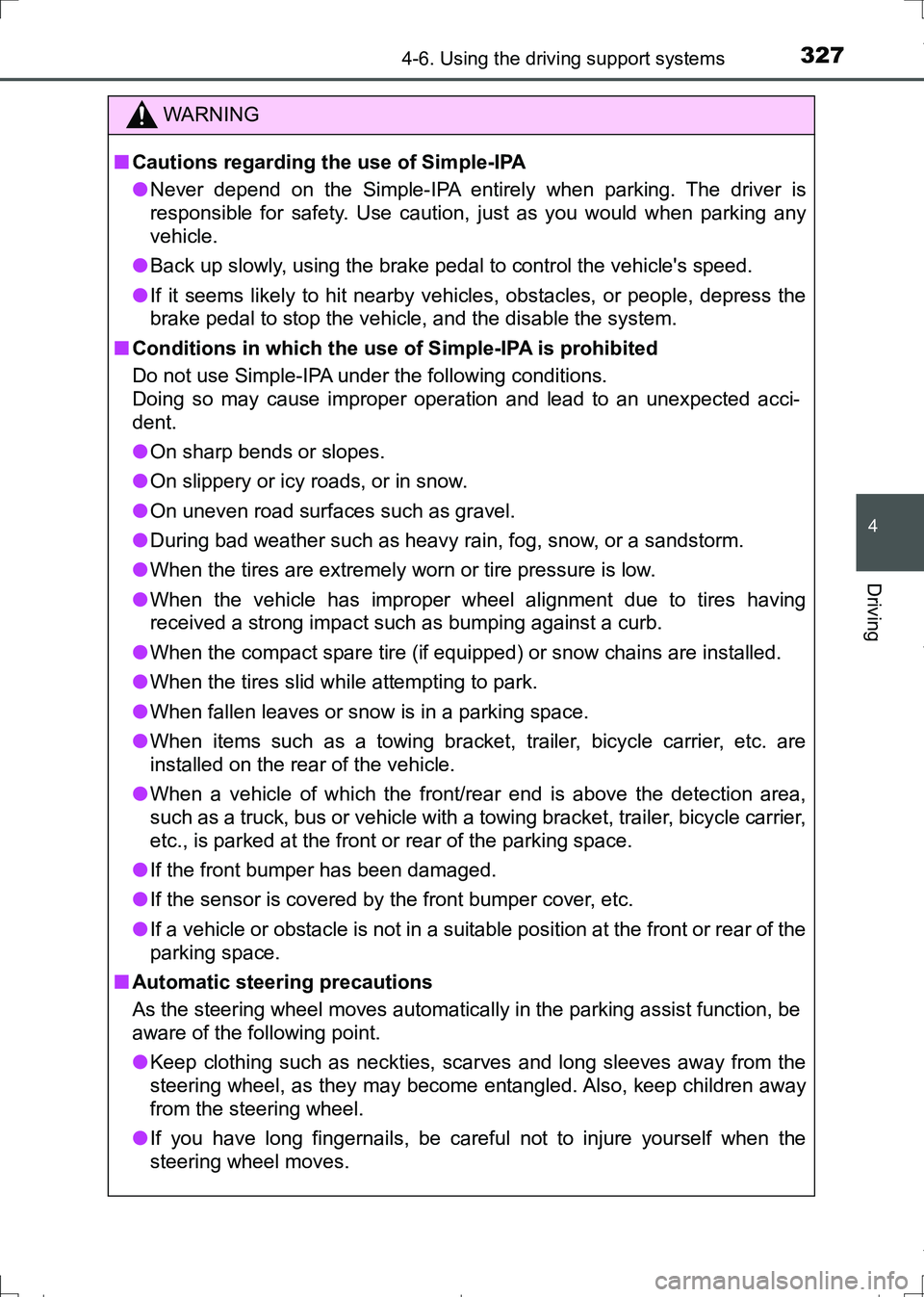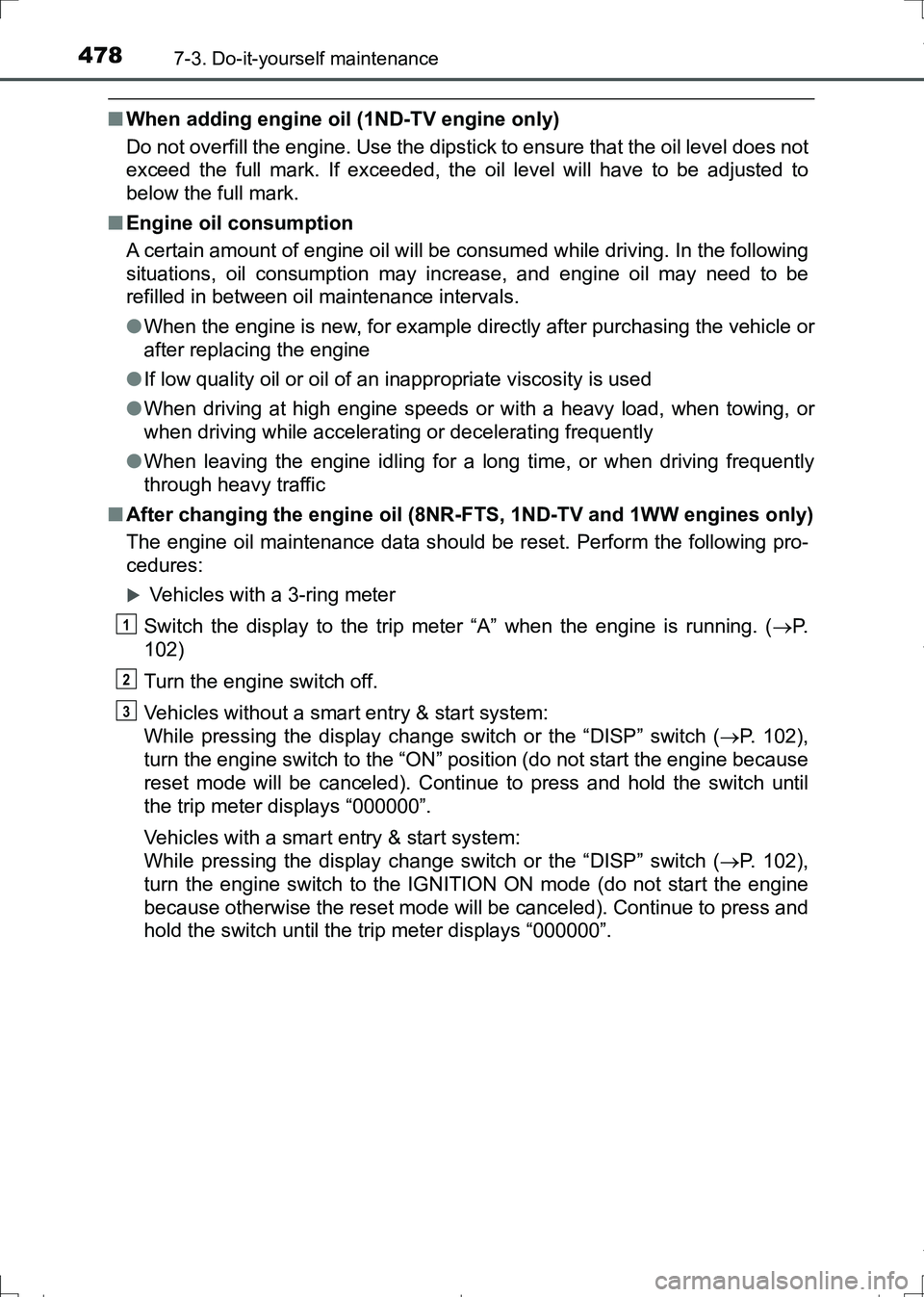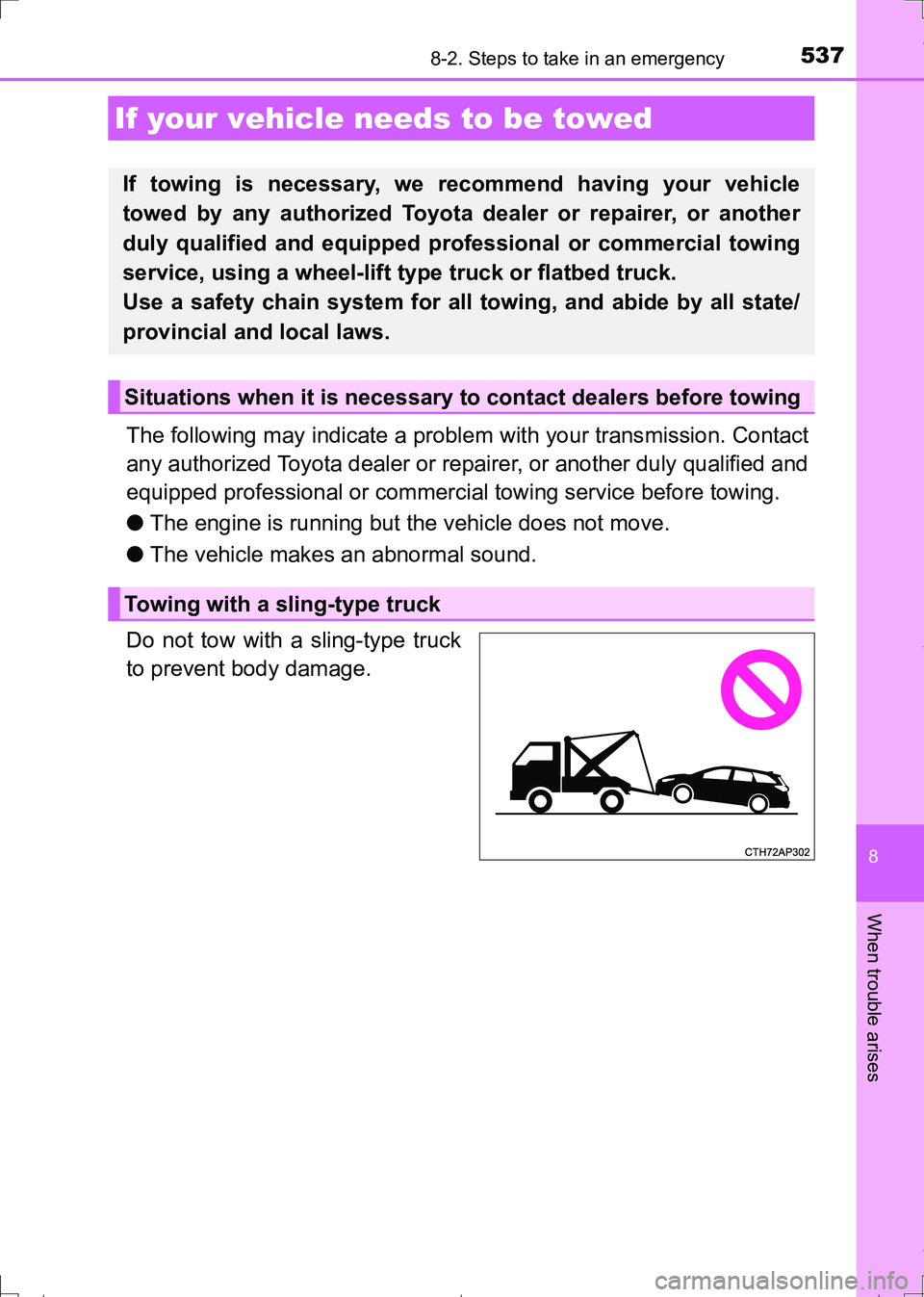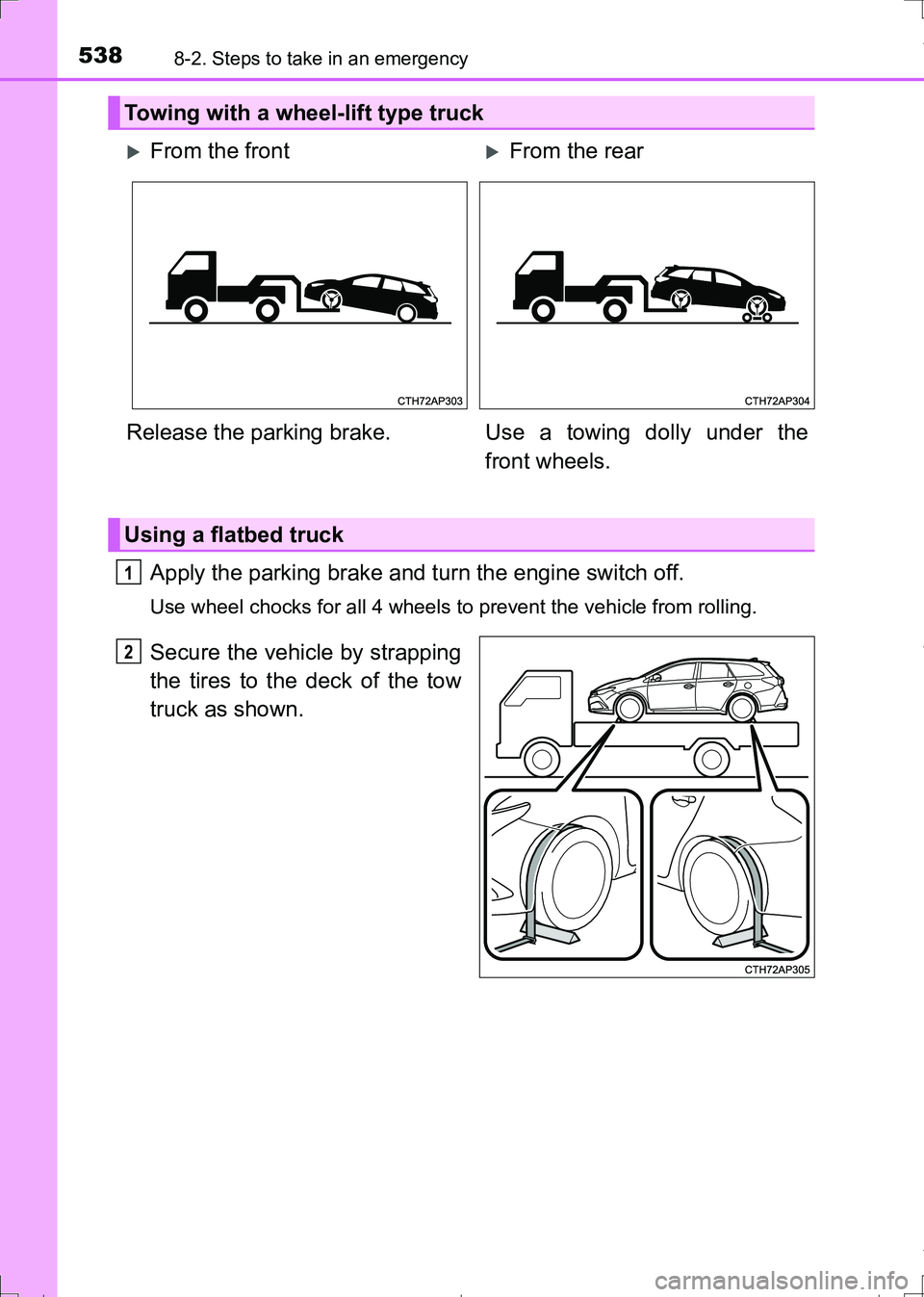2017 TOYOTA AURIS HYBRID towing
[x] Cancel search: towingPage 313 of 664

3134-6. Using the driving support systems
AURIS Touring Sports_EE (12L13E)
4
Driving
■The Toyota parking assist-sensor can be operated when
Vehicles without a smart entry & start system:
The engine switch is in the “ON” position.
Vehicles with a smart entry & start system:
The engine switch is in IGNITION ON mode.
●Front sensors:
• Vehicles with a Multidrive:
The shift lever is in a position other than P.
• Vehicles with a manual transmission:
The parking brake is not applied.
• The vehicle speed is less than about 10 km/h (6 mph).
(At any speed when the shift lever is in R)
●Rear sensors:
The shift lever is in R.
■Sensor detection information
●Certain vehicle conditions and the surrounding environment may affect the
ability of the sensor to correctly detect obstacles. Particular instances where
this may occur are listed below.
• There is dirt, snow or ice on the sensor.
• A sensor is frozen.
• A sensor is covered in any way.
• The vehicle is leaning considerably to one side.
• On an extremely bumpy road, on an incline, on gravel, or on grass.
• The vicinity of the vehicle is noisy due to vehicle horns, motorcycle
engines, air brakes of large vehicles, or other loud noises producing ultra-
sonic waves.
• There is another vehicle equipped with parking assist sensors in the
vicinity.
• A sensor is coated with a sheet of spray or heavy rain.
• The vehicle is equipped with a fender pole or wireless antenna.
• Towing eyelet is installed.
• A bumper or sensor receives a strong impact.
• The vehicle is approaching a tall or curved curb.
• In harsh sunlight or intense cold weather.
• A non-genuine Toyota suspension (lowered suspension etc.) is installed.
In addition to the examples above, there are instances in which, because of
their shapes, signs and other objects may be judged by the sensor to be
closer than they are.
AURIS Touring Sports_OM_Europe_OM12L13E.book 313 ページ 2016年6月27日 月曜日 午後5時21分
Page 327 of 664

3274-6. Using the driving support systems
AURIS Touring Sports_EE (12L13E)
4
Driving
WARNING
■Cautions regarding the use of Simple-IPA
●Never depend on the Simple-IPA entirely when parking. The driver is
responsible for safety. Use caution, just as you would when parking any
vehicle.
●Back up slowly, using the brake pedal to control the vehicle's speed.
●If it seems likely to hit nearby vehicles, obstacles, or people, depress the
brake pedal to stop the vehicle, and the disable the system.
■Conditions in which the use of Simple-IPA is prohibited
Do not use Simple-IPA under the following conditions.
Doing so may cause improper operation and lead to an unexpected acci-
dent.
●On sharp bends or slopes.
●On slippery or icy roads, or in snow.
●On uneven road surfaces such as gravel.
●During bad weather such as heavy rain, fog, snow, or a sandstorm.
●When the tires are extremely worn or tire pressure is low.
●When the vehicle has improper wheel alignment due to tires having
received a strong impact such as bumping against a curb.
●When the compact spare tire (if equipped) or snow chains are installed.
●When the tires slid while attempting to park.
●When fallen leaves or snow is in a parking space.
●When items such as a towing bracket, trailer, bicycle carrier, etc. are
installed on the rear of the vehicle.
●When a vehicle of which the front/rear end is above the detection area,
such as a truck, bus or vehicle with a towing bracket, trailer, bicycle carrier,
etc., is parked at the front or rear of the parking space.
●If the front bumper has been damaged.
●If the sensor is covered by the front bumper cover, etc.
●If a vehicle or obstacle is not in a suitable position at the front or rear of the
parking space.
■Automatic steering precautions
As the steering wheel moves automatically in the parking assist function, be
aware of the following point.
●Keep clothing such as neckties, scarves and long sleeves away from the
steering wheel, as they may become entangled. Also, keep children away
from the steering wheel.
●If you have long fingernails, be careful not to injure yourself when the
steering wheel moves.
AURIS Touring Sports_OM_Europe_OM12L13E.book 327 ページ 2016年6月27日 月曜日 午後5時21分
Page 478 of 664

4787-3. Do-it-yourself maintenance
AURIS Touring Sports_EE (12L13E)
■When adding engine oil (1ND-TV engine only)
Do not overfill the engine. Use the dipstick to ensure that the oil level does not
exceed the full mark. If exceeded, the oil level will have to be adjusted to
below the full mark.
■Engine oil consumption
A certain amount of engine oil will be consumed while driving. In the following
situations, oil consumption may increase, and engine oil may need to be
refilled in between oil maintenance intervals.
●When the engine is new, for example directly after purchasing the vehicle or
after replacing the engine
●If low quality oil or oil of an inappropriate viscosity is used
●When driving at high engine speeds or with a heavy load, when towing, or
when driving while accelerating or decelerating frequently
●When leaving the engine idling for a long time, or when driving frequently
through heavy traffic
■After changing the engine oil (8NR-FTS, 1ND-TV and 1WW engines only)
The engine oil maintenance data should be reset. Perform the following pro-
cedures:
Vehicles with a 3-ring meter
Switch the display to the trip meter “A” when the engine is running. (P.
102)
Turn the engine switch off.
Vehicles without a smart entry & start system:
While pressing the display change switch or the “DISP” switch (P. 102),
turn the engine switch to the “ON” position (do not start the engine because
reset mode will be canceled). Continue to press and hold the switch until
the trip meter displays “000000”.
Vehicles with a smart entry & start system:
While pressing the display change switch or the “DISP” switch (P. 102),
turn the engine switch to the IGNITION ON mode (do not start the engine
because otherwise the reset mode will be canceled). Continue to press and
hold the switch until the trip meter displays “000000”.
1
2
3
AURIS Touring Sports_OM_Europe_OM12L13E.book 478 ページ 2016年6月27日 月曜日 午後5時21分
Page 537 of 664

537
AURIS Touring Sports_EE (12L13E)
8
When trouble arises
8-2. Steps to take in an emergency
The following may indicate a problem with your transmission. Contact
any authorized Toyota dealer or repairer, or another duly qualified and
equipped professional or commercial towing service before towing.
●The engine is running but the vehicle does not move.
●The vehicle makes an abnormal sound.
Do not tow with a sling-type truck
to prevent body damage.
If your vehicle needs to be towed
If towing is necessary, we recommend having your vehicle
towed by any authorized Toyota dealer or repairer, or another
duly qualified and equipped professional or commercial towing
service, using a wheel-lift type truck or flatbed truck.
Use a safety chain system for all towing, and abide by all state/
provincial and local laws.
Situations when it is necessary to contact dealers before towing
Towing with a sling-type truck
AURIS Touring Sports_OM_Europe_OM12L13E.book 537 ページ 2016年6月27日 月曜日 午後5時21分
Page 538 of 664

5388-2. Steps to take in an emergency
AURIS Touring Sports_EE (12L13E)
Apply the parking brake and turn the engine switch off.
Use wheel chocks for all 4 wheels to prevent the vehicle from rolling.
Secure the vehicle by strapping
the tires to the deck of the tow
truck as shown.
Towing with a wheel-lift type truck
From the frontFrom the rear
Release the parking brake. Use a towing dolly under the
front wheels.
Using a flatbed truck
1
2
AURIS Touring Sports_OM_Europe_OM12L13E.book 538 ページ 2016年6月27日 月曜日 午後5時21分
Page 539 of 664

5398-2. Steps to take in an emergency
AURIS Touring Sports_EE (12L13E)
8
When trouble arises
If a tow truck is not available in an emergency, your vehicle may be
temporarily towed using cables or chains secured to the emergency
towing eyelets. This should only be attempted on hard surfaced roads
for at most 80 km (50 miles) at under 30 km/h (18 mph).
A driver must be in the vehicle to steer and operate the brakes. The
vehicle's wheels, drive train, axles, steering and brakes must be in
good condition.
Take out the towing eyelet. (P. 564, 578)
Remove the eyelet cover using
a flathead screwdriver.
To prevent damage, cover the tip of
the screwdriver with a rag.
Insert the towing eyelet into the
hole and tighten partially by
hand.
Emergency towing
Emergency towing procedure
1
2
3
AURIS Touring Sports_OM_Europe_OM12L13E.book 539 ページ 2016年6月27日 月曜日 午後5時21分
Page 540 of 664

5408-2. Steps to take in an emergency
AURIS Touring Sports_EE (12L13E)
Tighten down the towing eyelet
securely using a wheel nut
wrench
* or hard metal bar.
*: If the vehicle is not equipped with a
wheel nut wrench, a wheel nut
wrench can be purchased at any
authorized Toyota dealer or
repairer, or another duly qualified
and equipped professional.
Securely attach cables or chains to the towing eyelet.
Take care not to damage the vehicle body.
Vehicles without a smart entry & start system: Enter the vehicle
being towed and start the engine.
If the engine does not start, turn the engine switch to the “ON” position.
Vehicles with Stop & Start system: Before towing the vehicle, turn the
engine switch off once, and then start the engine.
Vehicles with a smart entry & start system: Enter the vehicle being towed
and start the engine.
If the engine does not start, turn the engine switch to IGNITION ON mode.
Vehicles with Stop & Start system: Before towing the vehicle, turn the
engine switch off once, and then start the engine.
Shift the shift lever to N and release the parking brake.
When the shift lever cannot be shifted: P. 2 2 8
■While towing
If the engine is not running, the power assist for the brakes and steering will
not function, making steering and braking more difficult.
■Wheel nut wrench
Vehicles without a wheel nut wrench: Wheel nut wrench can be purchased at
any authorized Toyota dealer or repairer, or another duly qualified and
equipped professional.
Vehicles with a wheel nut wrench: Wheel nut wrench is installed in the lug-
gage compartment. (P. 564)
4
5
6
7
AURIS Touring Sports_OM_Europe_OM12L13E.book 540 ページ 2016年6月27日 月曜日 午後5時21分
Page 541 of 664

5418-2. Steps to take in an emergency
AURIS Touring Sports_EE (12L13E)
8
When trouble arises
WARNING
Observe the following precautions.
Failure to do so may result in death or serious injury.
■When towing the vehicle
■To prevent causing serious damage to the Stop & Start system when
towing (vehicles with a Stop & Start system)
Never tow this vehicle with four wheels on the ground. Use a flatbed truck,
or lift up front or rear of the vehicle by using a wheel-lift type truck.
■While towing
●When towing using cables or chains, avoid sudden starts, etc. which place
excessive stress on the towing eyelets, cables or chains. The towing eye-
lets, cables or chains may become damaged, broken debris may hit peo-
ple, and cause serious damage.
●Vehicles without a smart entry & start system: Do not turn the engine
switch to the “LOCK” position.
There is a possibility that the steering wheel is locked and cannot be oper-
ated.
Vehicles with a smart entry & start system: Do not turn the engine switch
off.
There is a possibility that the steering wheel is locked and cannot be oper-
ated.
■Installing towing eyelets to the vehicle
Make sure that towing eyelets are installed securely.
If not securely installed, towing eyelets may come loose during towing.
Be sure to transport the vehicle with the
front wheels raised or with all four wheels
raised off the ground. If the vehicle is
towed with the front wheels contacting
the ground, the drivetrain and related
parts may be damaged.
AURIS Touring Sports_OM_Europe_OM12L13E.book 541 ページ 2016年6月27日 月曜日 午後5時21分